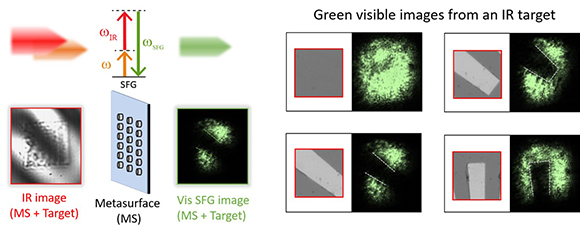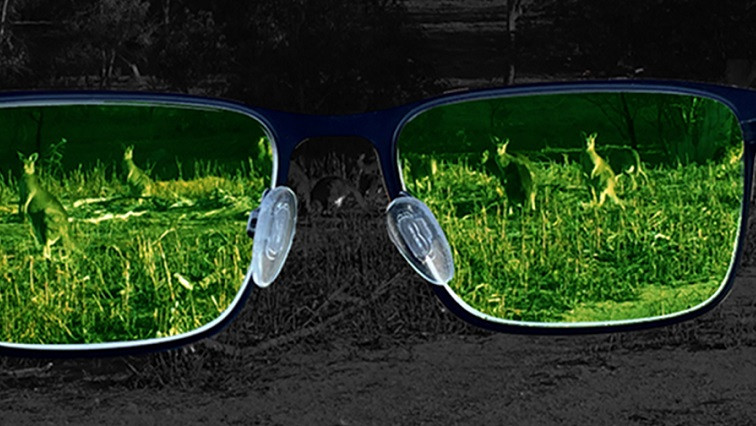The demand for detecting infrared (IR) light, invisible to human eyes, is constantly growing, due to a wide variety of applications ranging from food quality control and remote sensing to night vision devices and lidar. Commercial IR cameras require the conversion of infrared light to electrons and the projection of the resultant image on a display. This display blocks the transmission of visible light, thereby disrupting normal vision. Moreover, such IR detectors require low temperature and even cryogenic cooling due to the low energies of the IR photons, making IR detectors bulky and heavy.
An all-optical alternative to traditional cameras is the use of a nonlinear optical process to convert IR light into visible. In this case, electrical signals are no longer involved in the IR detection process, and the image, converted to the visible, can be captured by eye or phone-type camera. The optical process employed in this technique is nonlinear sum-frequency generation (SFG). In the SFG process, two incident photons, one of them in the IR spectrum, interact within a nonlinear material to generate emission at higher and visible frequencies. However, in the usual approaches this conversion relies on bulky and expensive nonlinear crystals.
A very attractive platform to overcome these limitations is the use of ultrathin nanocrystal layers known as metasurfaces. Metasurfaces are planar arrays of densely packed nanoantennas, designed to manipulate various properties of the incident light including its frequency. Among various examples, dielectric and semiconductor metasurfaces have shown great promise to enhance nonlinear optical processes at the nanoscale. Such metasurfaces can exhibit enhanced frequency conversion due to the excitation of optical resonances and good coupling to free space. Thus, the use of nonlinear metasurfaces is a promising way to up-convert IR photons to visible and thereby image IR objects through coherent conversion using ultrathin and ultralight devices. Importantly, transparent metasurfaces could perform IR imaging in a transmission configuration and simultaneously transmit visible light to allow for normal vision.
With this idea in mind, researchers from The Australian National University, Nottingham Trent University, and collaborators worldwide managed to demonstrate IR imaging via nonlinear metasurfaces composed of small semiconductor nanocrystals. As reported in Advanced Photonics, the researchers designed a multiresonant metasurface to enhance the field at all the frequencies participating in the SFG process. The designed metasurface was fabricated and transferred to a transparent glass, forming a layer of nanocrystals on the glass surface.

Through the sum-frequency generation (SFG) nonlinear optical process, two incident photons, one of them in the IR spectrum, interact within the metasurface to generate emission at green visible frequencies. More importantly, an IR image of a target is mixed with a second beam, within the metasurface, generating a green visible image via SFG. Optical microscope images of different transverse positions of the target (left-hand side) and their corresponding up-converted images (right-hand side).
In the experiment, an IR image of a Siemens-star target illuminated the metasurfaces. The IR image of the target was mixed with a second beam and, through the SFG process, up-converted to a visible wavelength at 550 nm (green light). The visible green images, captured with a conventional camera, correspond to different transverse positions of the target, including the case when the target was fully removed from the path of the IR beam and the SFG emission from the metasurface was observed. Despite different parts of the IR signal beam being up-converted by independent nanocrystals composing the metasurface, the images were well reproduced into the visible.
The proposed metasurface-based IR imaging approach offers novel opportunities not possible in conventional up-conversion systems. For example, the use of counter-propagating excitation beams, as well as incidence at different angles and, most importantly, multicolor IR imaging by an appropriately designed metasurface. Therefore, the results obtained by the researchers can benefit the future development of compact night vision instruments and sensor devices, offering an ultrathin and ultracompact platform and new functionalities such as multicolor IR imaging at room temperature.
Read the original article on Society of Photo-Optical Instrumentation Engineers (SPIE).







